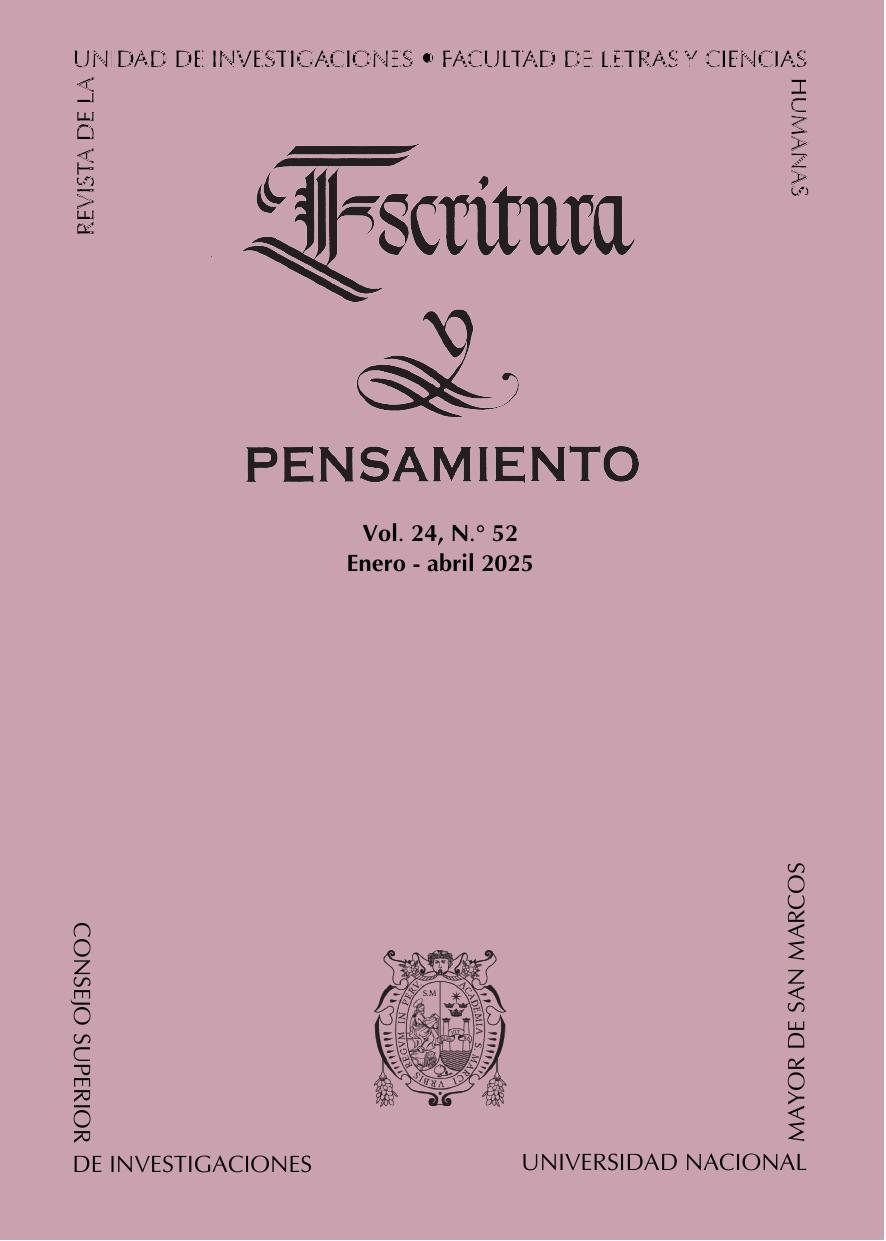Analysis of schematic images in the X (Twitter) messages of south american politicians
DOI:
https://doi.org/10.15381/escrypensam.v24i52.29729Keywords:
Schematic images, Political discourse, Twitter, Image AnalysisAbstract
In this article, three schematic images present in the messages on X, formerly Twitter, of five South American political figures are analyzed. The images were categorized into three groups: COUNTERFORCE, CONTAINER, and SCALE (VERTICALITY). The methodology used included a qualitative approach to examine the content of the messages. The results indicate that COUNTERFORCE images predominate when discussing groups perceived as opponents, while CONTAINER images promote integration. Finally, SCALE (VERTICALITY) images are often used to generate identification as well as to highlight the outlined policy objectives.
References
Agustín, Ó. G., y Cossarini, P. (2024). Scaling populism: the discursive articulation of spaces by Vox on Twitter. European Politics and Society, 1–19. https://doi.org/10.1080/23745118.2024.2364612
Arce, L. (2024). Tuit de Luis Arce [@LuchoXBolivia] sobre la violencia. https://x.com/LuchoXBolivia/status/1851409650282811500
Boric, G. (2024). Tuit de Gabriel Boric [@GabrielBoric] sobre la nueva ley en Chile. https://x.com/GabrielBoric/status/1859226219708842293
Da Silva, L. L. (2024). Tuit de Luiz Lula [@LulaOficial] sobre la construcción de casas en Brasil. https://x.com/LulaOficial/status/1861426268933107994
Duncombe, C. (2019). The Politics of Twitter: Emotions and the Power of Social Media. International Political Sociology, 13(4), 409–429. https://doi.org/10.1093/ips/olz013
Gil de Zúñiga, H., Goyanes, M., y Mateos, A. (2024). Twitter Communication Among Democracy Actors: How Interacting With Journalists and Elected Officials Influence People’s Government Performance Assessment and Trust. Social Media + Society, 10(1). https://doi.org/10.1177/20563051241232907
Hedblom, M. M., Kutz, O., y Neuhaus, F. (2018). Chapter 4 Image Schemas and Concept Invention. 99–132. https://doi.org/10.1007/978-3-319-65602-1_4
Johnson, M. (1987). The Body in the Mind. University of Chicago Press.
Johnson, M. (2017). Embodied mind, meaning and reason, University of Chicago Press
Jungherr, A. (2015). Twitter as Political Communication Space: Publics, Prominent Users, and Politicians. In Contributions to Political Science (pp. 69–106). Springer, Cham. https://doi.org/10.1007/978-3-319-20319-5_4
Kimmel, M. (2009). Analyzing image schemas in literature. Cognitive Semiotics, 5(s1), 159-188.
Lou, A. (2017). Viewpoint and image schemas in multimodal political discourse. Journal of Pragmatics. http://dx.doi.org/10.1016/j.pragma.2017.07.002
Martín de la Rosa, V. (2023). Taking back control: The role of image schemas in the Brexit discourse. Russian Journal of Linguistics, 27(2), 276–296. https://doi.org/10.22363/2687-0088- 31509
Milei, J. (2024).Tuit de Javier Milei [@JMilei] sobre la mentira en el periodismo. https://x.com/JMilei/status/1861202284702515706
Otieno, R. F., Owino, F. R., Attyan, J. M., y Ogone, J. O. (2017). Image schemas in political discourse in Kenya. European Journal of Research in Social Sciences, 5(2), 71–77.
Peña Cervel, M. S (2016). Los esquemas de imagen. En I. Ibarretxe-Antuñano & J. Valenzuela (directores). Lingüística Cognitiva, Barcelona: Anthropos Editorial
Petro, G. (2024). Tuit de Gustavo Petro [@petrogustavo] sobre el capitalismo. https://x.com/petrogustavo/status/1851591126907556167
Sadler, N. (2018). Narrative and interpretation on Twitter: Reading tweets by telling stories. New Media & Society, 20(9), 3266– 3282. https://doi.org/10.1177/1461444817745018
Salih, B. R., Hama Sur, S. A. y Mohammed, S. S. (2024). Understanding political persuasion: Analyzing image schemas as catalysts in campaign strategies. Journal of University of Human Development, 10(1), 42-47. https://doi.org/10.21928/juhd.v10n1y2024.pp42-47
Tseng, M. Y. (2007). Exploring image schemas as a critical concept: Toward a critical-cognitive linguistic account of image-schematic interactions. Journal of Literary Semantics 36(2):135- 157. https://doi.org/10.1515/JLS.2007.008
Yang, T. (2016). Image Schemas in Verb–Particle Constructions: Evidence from a Behavioral Experiment. Journal of Psycholinguistic Research, 45(2), 379–393. https://doi.org/10.1007/S10936-015-9354-6/METRICS
Zhu, Z. (2023). A Literature Review of the Image Schema Theory and Concepts of Construction. International Journal of Languages, Literature and Linguistics, 9(4), 542–546. https://doi.org/10.18178/IJLLL.2023.9.6.467
Downloads
Published
Issue
Section
License
Copyright (c) 2025 Antonieta Cecilia Carrasco Del Carpio

This work is licensed under a Creative Commons Attribution 4.0 International License.
AUTHORS RETAIN THEIR RIGHTS:
a. The authors retain their trademark and patent rights, and also over any process or procedure described in the article.
b. The authors retain the right to share, copy, distribute, execute and publicly communicate the article published in the Escritura y Pensamiento (for example, place it in an institutional repository or publish as part a book), with acknowledgment of its initial publication by Escritura y Pensamiento.
c. Authors retain the right to make a subsequent publication of their work, to use the article or any part of it (for example: a compilation of their work, lecture notes, thesis, or for a book), provided that they indicate the source of publication (authors of the work, journal, volume, number and date).





